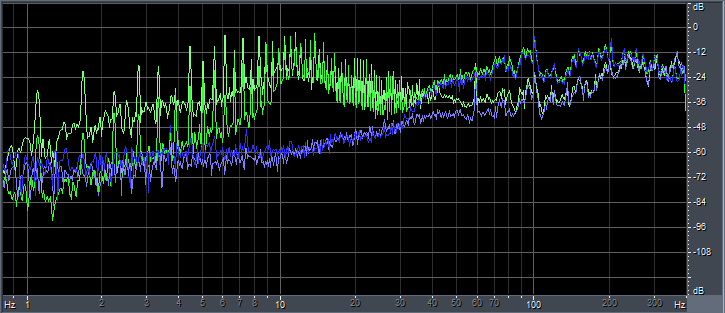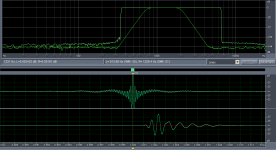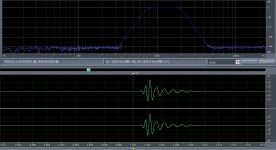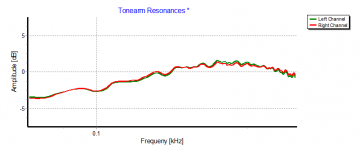So what did you get to pay for the honor?
$75, I did get an appreciation for your end of the business. (BTW I took an extra jersey
Last edited:
Looks OK to me in terms of damping and roll-off. The resonance or corner f might be a bit low, and the penalty then is that attenuation at frequencies c 4-6Hz isn't very large. So sources like pinch warp might be more prevalent than desirable, but more generally as to the other benefits of a stable and well damped setup, that looks good to me, Jan. I might not expect it necessary or audible to have a seperate electronic filter.So if the mech cartridge/arm resonance is not there, or at a too high frequency, what does that say about the mech properties? Does that mean that the cart is too heavy and/or the arm too damped?
See attached; one is a 'good' (I think) setup, the other less so
Jan
Looks OK to me in terms of damping and roll-off. The resonance or corner f might be a bit low, and the penalty then is that attenuation at frequencies c 4-6Hz isn't very large. So sources like pinch warp might be more prevalent than desirable, but more generally as to the other benefits of a stable and well damped setup, that looks good to me, Jan. I might not expect it necessary or audible to have a seperate electronic filter.
Yeah that's what I thought. Now how should I fix that other one?
But you can readily produce an audible result which appears to disobey causality for all practical purposes..........Separately, you cannot disobey causality. God does not play dice with time, to paraphrase uncle A.
Yes it is. As you confirmed. Measure the LF ringing of your arm resonance. Set an analog active notch filter with the same resonance frequency and Q. Flat response curve, 0 group delay there.
Nothing but a pure audiophile reproduction, with surface noise, cracks, distortions, accidents in the response curve, and colorations or character that you can adjust to your taste, just by changing the head.
Tonearm does not have simple resonance. This is typical of low frequency response of record:

This data is from: Listening test - do you prefer CD or vinyl version
Blueish traces are CD version, which used same master as vinyl version. Eccentricity of center hole of record is a dominant player, but every little transient in the record groove also excites tonearm resonances.
Tonearm damping is typically only damped by cantilever suspension. Other damping point is tonearm pivot, which a few turntables such as Denon DP35/45 with servo control of tracking force and anti-skating.
DP35F was last turntable I owned. It could track warped records that would send most tonearms airborne. Badly off center records also played without woofer flopping about.
Well, that much is true. There are two degrees of freedom to headshell motion, and so the resonant system is described in 2D as motion within a spherical arc section, or approx as motion within a plain. So a displacement of the headshell results in 2D motion, perhaps like a lissajous figure, if you get my drift.Tonearm does not have simple resonance.
Spring, inertia, and damping vary by vertical
Those spectra you posted aren't representative IME and I'm not sure at all what they are meant to show...............
Yes ! Including variation in stylus-groove friction, which is one of the largest unrecognised sources IMO. The elephant in the room...... but every little transient in the record groove also excites tonearm resonances.
Tonearm does not have simple resonance. This is typical of low frequency response of record:

This data is from: Listening test - do you prefer CD or vinyl version
Blueish traces are CD version, which used same master as vinyl version. Eccentricity of center hole of record is a dominant player, but every little transient in the record groove also excites tonearm resonances.
Tonearm damping is typically only damped by cantilever suspension. Other damping point is tonearm pivot, which a few turntables such as Denon DP35/45 with servo control of tracking force and anti-skating.
DP35F was last turntable I owned. It could track warped records that would send most tonearms airborne. Badly off center records also played without woofer flopping about.
-RNM
No worries, yes,yes, no to the 3 questions. Say the linear phase filter is real time, and at t=0 there is a unit impulse. The output of the filter in time after t=0 is a symmetrical waveform, beginning with a pre-ring, then a broadened peak, then a post-ring.
The peak occurs at a time after t=0, known as 'latency', depending on the implementation of the filter. So, relative to the audible location of the filtered peak, the pre-ring appears to occur before it in time.
Yes under these conditions convolving Dirac returns filter function. Dirac is full bandwidth stimulus. When bandwidth of stimulus is within bandwidth of linear phase system, only latency is present:
Using Cool Edit a silent two channel track at sample rate 48kHz is generated, of 96k zero value samples, then sample values for sample 48k in each track are set to normalized value of 1; this would be sample value of 32768 for 16bit rendering or 8388608 for 24bit rendering. The waveforms have all energy in single sample; spectrum is flat 0Hz-24kHz. Band pass filtering is applied to each track. Filters for upper displayed track are FIR filters applied with Cool Edit’s FFT filtering tool. FFT is set up with Blackman-Harris windowing; a 16384 point 350Hz high pass filter and a 4096 point 6500Hz low pass filter are applied. IIR filters are applied to lower displayed track using Cool Edit’s Butterworth 10th order filters (BW10); BW10 high pass with 750Hz cuttoff and BW10 low pass with 2000Hz cutoff are each applied twice, giving resultant filter with Linkwitz-Riley type slopes:

In the above sample 48000 at 1 second is marked as t=0 where all the energy started out. For FIR filtering energy is symmetrically distributed on both sides of t=0.
For IIR filtering the impulse starts at t=0, but the energy is peaking about 2ms later. This is group delay, pure and simple. If IIR waveform is looked at closely, it is seen that
In reality, no IIR is infinite, decaying into noise floor. The band pass IIR filter generated here decays to all zero values after 1496 samples. The IIR is copied to clipboard and convolved with entire 96000 samples of the FIR filter:

No pre-ringing is seen. The FIR filter passes the IIR filter unaltered with exception of added math noise.
Really, in what way ?Good real-world info.
How could we improve on this?
Subsonic / Rumble Filter for Phono preamps and Sub-Woofers
THx-RNMarsh
Subsonic / Rumble Filter for Phono preamps and Sub-Woofers
THx-RNMarsh
Interesting book on low freq, low noise measurement and reductions etc. Quantum noise issues;
Advanced Experimental Methods for Noise Research in Nanoscale Electronic | Springer
THx-RNMarsh
Advanced Experimental Methods for Noise Research in Nanoscale Electronic | Springer
THx-RNMarsh
An extra filter should be unnecessary if the resonance is controlled well mechanically IME.
I am sure you know enough for not to oversimplify it.
Since my first post on arm/cart resonance in this thread, I am an advocate of taming the mechanical resonance where it happens by mechanic means (frequency through cart compliance/arm effective mass matching and amplitude through damping). I’ve repeated the caution that any electronic filtering won’t undo the generation of intermodulation products generated at the cartridge due to this mechanical resonance. See here
All of the mechanical components imprint their signatures on the electrical waveform of the cartridge. Pitch change, freq modulation, amplitude modulation, vibrato, tremolo are all there across the complete freq spectrum.
HP electric filtering -passive or active- right at the preamp input will not change this but it will reduce the additional repeating of this modulation process at the amplifying stages –which may be significant-and will protect from LF overload.
DSP processing by convoluting the cartridge signal with the impulse response of the complete mechanical system would provide a cure but this impulse response is strongly amplitude dependant, so there is no straight DSP cure either.
here too
and hereMr Curl this post
Remember that the primary mixing
Really, in what way ?
Can you try to FFT a blank lead-in or lead-out vinyl grove recording with your TT set? Only please pay attention on the frequency resolution (less than 0.5 Hz)
So if the mech cartridge/arm resonance is not there, or at a too high frequency, what does that say about the mech properties? Does that mean that the cart is too heavy and/or the arm too damped?
See attached; one is a 'good' (I think) setup, the other less so
Jan
Jan
I think your second measurement shows a system with a Q of less than 0.5 (too much damping).
The difference btn the two channels in this measurement suggests there are Q differences in the lateral direction.
What is the arm and what is the test signal?
Another question. What is the frequency resolution of your measuring system?
George
Last edited:
Jan
I think your second measurement shows a system with a Q of less than 0.5 (too much damping).
The difference btn the two channels in this measurement suggests there are Q differences in the lateral direction. What is the arm and what is the test signal?
Another question. What is the frequency resolution of your measuring system?
George
The test signal is a low frequency sweep (it's really a freq response measurement driven by a sine sweep) on the Adjust+ test record.
The test signal sampled at 44.1k/24 but I will redo it at 96k/24 when I get some time.
If the arm would be too heavily damped, wouldn't I see still some resonance of the cartridge? There is a separate test for the arm alone, which normally resonates at several 100 Hz. See example of the same arm.
Jan
Attachments
In reality, no IIR is infinite, decaying into noise floor. The band pass IIR filter generated here decays to all zero values after 1496 samples. The IIR is copied to clipboard and convolved with entire 96000 samples of the FIR filter:
View attachment 488520
No pre-ringing is seen. The FIR filter passes the IIR filter unaltered with exception of added math noise.
Not sure what you are trying to show here. An IIR at double precision floating point (-300dB noise floor) behaves quite differently than the same filter on a 16bit DSP. By definition an IIR filter is minimum phase and can not exhibit pre-ringing and opposed to conventional thought FIR filters can be either linear or minimum phase.
Last edited:
There would be no f response peak, in fact a sort of roll-off as frequency decreases, eventually becoming a -12dB/octave slope.If the arm would be too heavily damped, wouldn't I see still some resonance of the cartridge?
Trouble is that increasing mechanical damping increases forces on the stylus, requiring increased VTF to conserve trackability.........it's an equilibrium.
I think a Q of 2 or thereabouts is not a bad aim in practice.
Yes, I agree.Since my first post on arm/cart resonance in this thread, I am an advocate of taming the mechanical resonance where it happens by mechanic means (frequency through cart compliance/arm effective mass matching and amplitude through damping).
Barleywater, I timed out after 10 mins of trying hard to work out what you have done here, and what the point is.Using Cool Edit a silent two channel track at sample rate 48kHz is generated, of 96k zero value samples, then sample values for sample 48k in each track are set to normalized value of 1; this would be sample value of 32768 for 16bit rendering or 8388608 for 24bit rendering. The waveforms have all energy in single sample; spectrum is flat 0Hz-24kHz. Band pass filtering is applied to each track. Filters for upper displayed track are FIR filters applied with Cool Edit’s FFT filtering tool. FFT is set up with Blackman-Harris windowing; a 16384 point 350Hz high pass filter and a 4096 point 6500Hz low pass filter are applied. IIR filters are applied to lower displayed track using Cool Edit’s Butterworth 10th order filters (BW10); BW10 high pass with 750Hz cuttoff and BW10 low pass with 2000Hz cutoff are each applied twice, giving resultant filter with Linkwitz-Riley type slopes:.
Mathematical certainty is zero phase-shifts between harmonics. Pre-ripples have no relation with the signal contents, just with the steepness of the filter used.If you don't accept a mathematical certainty, backed by a clear audible demo with a common sense explanation, there's just no hope..........
We hear something before what we call "the actual signal" has arrived because
-a) Our hearing system is imperfect, that's an auditory illusion
-b) Even without the human imperfection, the reproduction chain destroys the theoretical perfection.
Another theoretical example: if I use a 0.1Hz bandpass filter to process a 1KHz tone-burst, I will begin to hear (or think I hear) the burst ~10s before the burst has actually (supposedly) begun, but in fact it is pure illusion, just an illustration of how imperfect we are.
Of course, when the time scale is within our direct grasp it is shocking, but at higher frequencies, or in other fields like image processing and enhancement, it is completely natural (or it looks that way)
Pre-ripples have no relation with the signal contents, just with the steepness of the filter used.
The pre-ripples are totally determined mathematically by the input data, a digital filter has nothing else to work on but the data that it is given.
- Status
- Not open for further replies.
- Home
- Member Areas
- The Lounge
- John Curl's Blowtorch preamplifier part II
